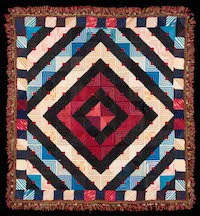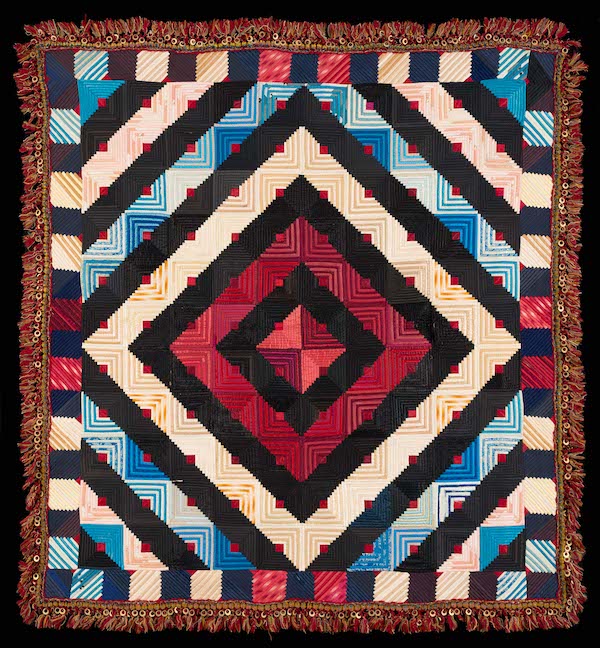
WILLIAMSBURG, Va. — Two new textile exhibitions will open at the Art Museums of Colonial Williamsburg on December 3, and are sure to delight museum visitors. Stitched in Time: American Needlework, an exhibition of nearly 60 examples of bedrugs, whitework, embroidered hand towels, quilted petticoats, samplers, mourning and commemorative needlework, crewelwork, needlework with religious and geographical influences as well as sewing accessories, will remain on view through January 2, 2025 at the DeWitt Wallace Decorative Arts Museum. Additionally, an entirely new rotation of objects in the popular exhibition The Art of the Quilter that opened in 2021 will feature 15 pieces, 12 of which are recent acquisitions that have never before been displayed. This configuration of the exhibition, which will remain on view through August 2023 at the Abby Aldrich Rockefeller Folk Art Museum, will include 11 large quilts, one woven coverlet and three doll-size quilts that tell stories about people from America’s past and the societies in which they lived.
Needlework and sewing were common threads in the lives of most 18th- and 19th-century women across social, economic and geographical boundaries. Early American women — whether poor, enslaved, indigenous, middle class or wealthy — contributed to their family’s household furnishings and enriched their homes and clothing by embellishing textiles with decorative stitches. Sewing and mending everyday household textiles, such as bed and table linens and clothing, was another way for women to contribute economically to their family. Stitching needlework projects was not only a creative outlet for many housewives, but was also an educational tool for young schoolgirls. These themes are the basis for Stitched in Time: American Needlework, which will be on view in the Len and Cyndy Alaimo Gallery. The exhibition will also highlight the diversity and regional variations of American needlework that can be traced through the ethnic origins of the makers, trade and migration patterns, influential teachers and artists, current fashions, religious affiliations, geography and even climate.
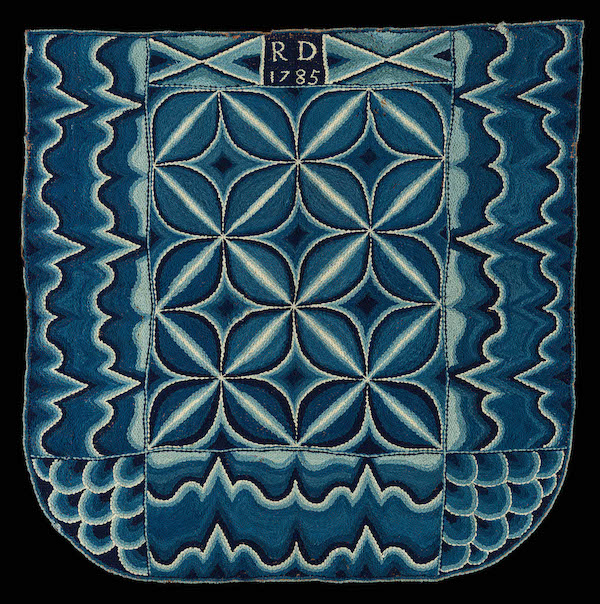
Among the many other highlights of Stitched in Time is a bed rug probably made in Norwich, Connecticut, in 1785 by an unknown maker who signed the rug “RD.” The rug relates to a group of embroidered rugs created in the Connecticut River Valley. It was made by darning, or stitching, closely spaced rows of heavy wool yarn through a woolen ground, leaving most of the stitches visible on the surface. The side and bottom borders consist of abstract scalloped and peaked lines similar in appearance to Irish stitch needlework, but worked with darning stitches. This bed rug is especially attractive because of its remarkable condition.
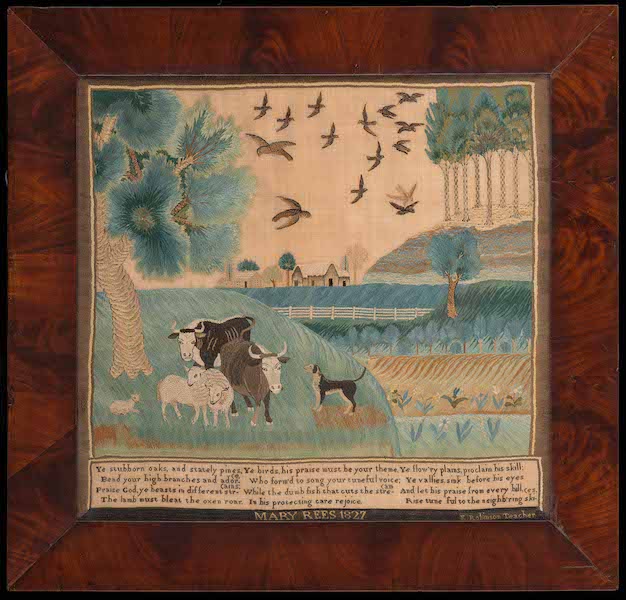
Among the many examples of extraordinary samplers in the exhibition is one made in 1827 by Mary Rees, a student of Elizabeth Robinson (1778-1865), in Montgomery County, Pennsylvania. Robinson, an unmarried woman who lived with her five unmarried sisters in their family homestead left to them by their father, worked as a schoolmistress to help support the family. At least eight samplers or pictures have been identified from Elizabeth Robinson’s school. Mary Rees’ cross-stitched verse and her pictorial composition made of silk and wool embroidery threads on a linen ground are perfectly suited to each other. The verse implores all living things to praise their Maker, while the imagery shows some of the plants and animals requested to pay such tribute. Rees’ careful selection of thread color and the direction and type of stitching makes the scene both decorative and naturalistic. The embroidered scene bordered in black stitches to imitate a reverse painted glass mat and the title, date and signature worked in bright threads to mimic a more expensive gold leaf inscription are characteristics found on other embroideries worked under the instruction of Elizabeth Robinson.
A highly sophisticated embroidered picture attributed by family history to Orra Sears (1798-1872) of Bloomfield, New York is another highlight of Stitched in Time. It is believed that Orra created the picture in 1816, when she was a boarding student at the Litchfield Female Academy in Connecticut. School records indicate that Orra attended the school that year; she was one of at least 2,000 girls from nearly every state who attended the academy from 1792 through 1833 when the school operated. Students from out of town, such as Orra, boarded with Litchfield families. American educational goals of the period stressed the proficient duplication in embroidery of idealized themes that were widely recognized and approved of, rather than the development of individual creativity. Needlework compositions were taken from existing illustrations, usually English engravings or other printed images. Here, at least four different prints depicting views of Chiswick, an English country house, were used to create the scene on Orra’s embroidered and painted picture.
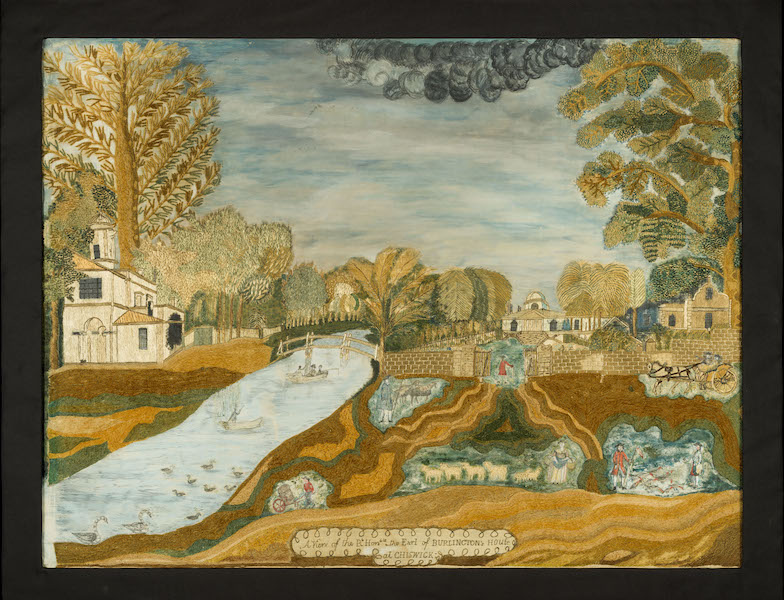
In its second year of a three-year exhibition, The Art of the Quilter’s latest rotation in the Foster and Muriel McCarl Gallery promises to continue delighting quilt aficionados with its new selection of quilts from the Colonial Williamsburg Foundation’s heralded collection that spans the early 19th century to present day. These diverse quilts allowed women to express artistic instincts while also creating a warm and practical bedcover for their loved ones. Making quilts was often a community activity, in which neighbors and relatives enjoyed the pleasures of joint work and socializing.
Among the highlights of The Art of the Quilter is a log cabin show quilt made by Geneva Luela Richards Graves (1862-1915) in Hampshire County, Massachusetts circa 1890. During the last quarter of the 19th century, when home decoration and beautification were a primary duty of Victorian housewives, the interest in show quilts reached its pinnacle. Most of these ornamental quilts were smaller than bed-size quilts and were usually made of silks and other fine fabrics with decorative stitches. Geneva’s small throw, made of rich-colored silk solids, plaids, stripes, textured weaves and velvets has the additional embellishments of metal bangles and wool, silk and metallic fringe. She worked from the center out to the edges of each smaller unit, building up the design with carefully chosen rectangles of fabric that represent logs of the cabin and purposely selected and assembled her fabrics to create bands of color in a concentric diamond shape. This is the first time this quilt will be on display at the Art Museums since it was acquired in 2020.
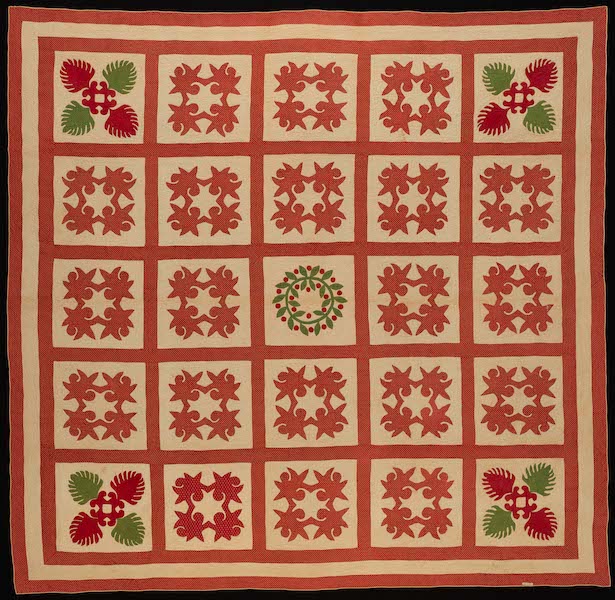
Album quilts, so called because their blocks were like pages from a book and comprised of individual appliqued or pieced blocks, became fashionable in the mid-1840s. While they could be worked entirely by one person, they are best known as the product of group efforts, with each maker contributing one or more of the blocks. An appliqued album quilt is another featured object in the exhibition. Made solely by Sarah Doub (1805-1878) in Frederick, Maryland in 1857 for her youngest son, Valentine David Doub, it is not known if he ever received the exquisite quilt as he immigrated to California in 1849 as a member of a mining company, and there is no evidence that he ever returned home. On the back of the quilt in the center is the handwritten inked inscription: “Made by/ Sarah Doub/ in the 52nd year of her/ age/ for her son/ Valentine David Doub/ Frederick City/ July 1857/ Maryland.” Twenty of the 25 blocks of the quilt have an appliqued fleur-de-lis motif, which is known by a number of different names; in Virginia’s Shenandoah Valley, it is called the Apple Pie Ridge Star, named for a nine-mile stretch of road in Frederic County, Virginia. This quilt also makes its exhibition debut at the Art Museums having also been acquired in 2020.

Another piece recently acquired in 2021 is a third highlight of The Art of the Quilter and is a remarkable and prize-winning example of pieced, or patchwork, quilting. A pieced and appliqued Sunburst quilt made by Mary Ann McPherson (1809-1901) in Charles County, Maryland between 1840 and 1850 is skillfully fashioned with finely quilted intricate florals, vines and diagonal lines. Each pieced sunburst motif contains 288 individually pieced diamonds. Adding to the quilt’s beauty and extravagance is a five-inch handwoven linen fringe attached to all four sides. The combined color schemes of red and green and blue, brown and pink is found on other Maryland quilts created in the 1840s and 1850s. The quilt descended through her brother’s family line to his granddaughter, Jane Virginia McPherson Burton, who was a school teacher. She stitched a label in the left corner of the quilt that reads: “Sunburst quilt / Made one hundred and / fifty years ago by / Mrs. Mary MacPherson / 1st prize 50c C. M. C.” Mary Ann was raised at Greenway, a tobacco plantation near Pomonkey, Maryland. Enslaved people worked in the home and fields to provide Mary and her six siblings a comfortable lifestyle, which enabled her leisure time to create quilts. A second quilt created by Mary Ann is a Mariner’s Compass pattern that also survives and is in this exhibition as well.
Stitched in Time and The Art of the Quilter promise to engage and delight the passionate needleworker of today, anyone who has received a special hand-stitched gift from a family member or friend, and all museum visitors of diverse ethnicities from different regions.
Additional information about the Art Museums and Colonial Williamsburg as well as tickets are available online at colonialwilliamsburg.org or by calling 855-296-6627.


